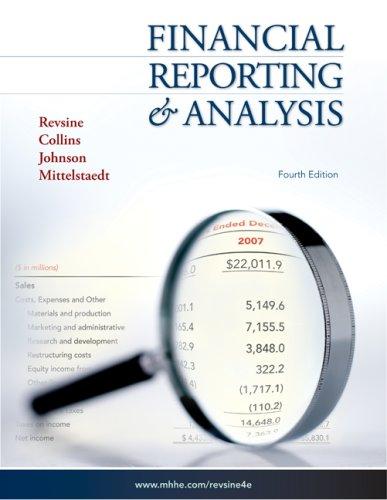The octogenarian founders of X-Rite Inc. spend less time these days on the golf course and more
Question:
The octogenarian founders of X-Rite Inc. spend less time these days on the golf course and more with estate planners, thanks to an accounting standard introduced last year.
This same accounting standard also led to charges against earnings, investor confusion and, ultimately, the scrapping of a share-repurchase plan for those retired founders of the company, which makes hardware and software that allows paint manufacturers, the dental industry and other customers to match colors.
At issue is a perhaps unintended consequence of the Financial Accounting Standards Board’s FAS 150, a guideline introduced by the accounting rule maker in May 2003.
The idea behind FAS 150 was to make sure companies properly account for certain types of preferred securities whose popularity has soared in recent years, in part because they allow companies to raise money without having to show more debt on their books.
Historically these securities were placed on corporate balance sheets in a kind of no-man’s land between liabilities and equity.
Under FAS 150, companies classify them as liabilities and account for dividend payments and changes in their value in the income statement—as part of profit or loss—under “interest expense.”
Here's how FAS 150 tripped up X-Rite: In 1998, the company agreed it would repurchase 4.5 million shares owned by its six aging founders after they and their spouses die. Management’s intent was to protect the illiquid stock from plummeting as a result of large share sales in the future by heirs cashing in to cover hefty estate taxes.
At the same time, X-Rite management took out insurance policies to cover the cost of buying back the shares, at prices that were capped and floored in the agreements. X-Rite paid monthly premiums on policies that would fund the future repurchases under the agreement plus extra repurchases should the heirs require.
Prior to FAS 150, X-Rite classified the value of the founders’
shares on its balance sheet as a separate line-item titled “temporary shareholders’ investment”—an equity instrument, in other words. The company “marked to market” those shares under that heading. The insurance policies were classified under “other assets” and reflected the accumulation of cash from X-Rite’s premium payments. Neither entry had any impact on the income statement.
Starting in the third quarter of 2003, however, a new X-Rite management team started classifying the shares as long-term liabilities to comply with FAS 150. Changes in the value of the shares flowed through as interest expense.
But as X-Rite’s share price started to rise under new management and better earnings, so too did the value of its founders shares—and the company’s interest expense.
In the fourth quarter of 2003, X-Rite took an interestexpense charge of \($657,000\) directly related to a rise in the value of the founders’ shares from the start of the year. In the first quarter of 2004, the charge climbed another \($4.77\) million; in the second quarter, another \($3.64\) million hit.
In just three quarters, X-Rite took charges of more than \($9\) million in interest expense on the founders’ shares, and the company posted net losses in two of those quarters. While these charges hit its bottom line as required by FAS 150, the fact that X-Rite had ample insurance to cover the liabilities was only evident on the balance sheet, not on the income statement, where most investors’ eyes are glued.
“This made it look like we don't have a hedged transaction, but we did because we had an insurance policy out there,” says Mary Chowning, X-Rite’s chief financial officer. “If you’re going to move toward fair-value accounting, you have to do it for everything.”
By the third quarter of this year, Ms. Chowning says, she was spending more than one-third of her time trying to explain the founders’ agreements to shareholders. She worried the “hairy problem” would keep X-Rite from attracting more institutional investors. The company’s share price began to sag.
Finally, this month Ms. Chowning persuaded X-Rite’s founders to unwind the agreements, and to improve their estate planning.
While the company now has an overhang of founders’
shares, “we traded one problem for a lesser problem,” she says.
FAS 150 is another step in FASB’s march toward fair value accounting, which values companies’ financial assets at current market prices rather than their original cost.
While FASB deliberates over future fair-value standards, companies like X-Rite can find themselves trapped between a mix of valuations—some at fair value, some at historical cost, and some in-between—as balance sheets evolve.
“That's the balance sheet we're currently living with,” says David Zion, an accounting analyst at CSFB in New York. “FASB is moving more of that balance sheet to fair value, but in the meantime, that’s what we deal with every single day”
A FASB board member says he and his colleagues are working on better guidance for companies on how to differentiate between debt and equity.
Required:
1. Explain why SFAS No. 150 requires X-Rite to classify its founders’ shares as part of long-term debt rather than stockholders’ equity.
2. How did the company “hedge” its financial obligation to buy back shares from its founders?
Based on the information provided in the news clip, was the hedge fully effective?
3. Why does it make sense that X-Rite was required to use mark-to-market accounting for its stock repurchase financial obligation?
4. Assuming that the hedge was fully effective, explain how mark-to-market accounting produced so much earnings volatility at X-Rite.
5. How has GAAP changed since 2004 in ways that would have allowed X-Rite to avoid the earnings volatility created by SFAS No. 150?
Step by Step Answer:






